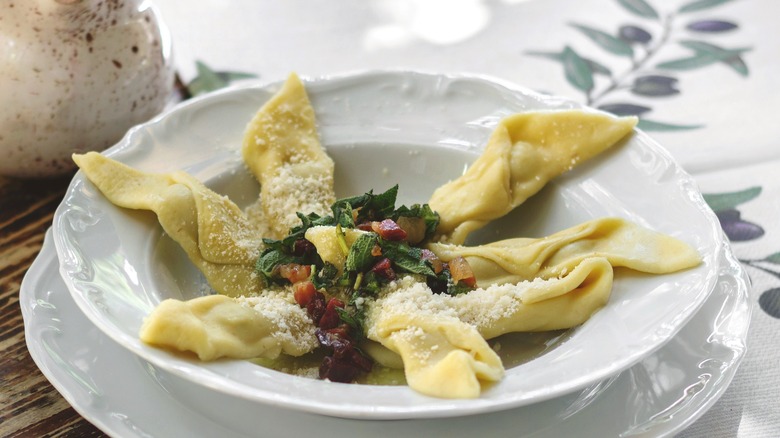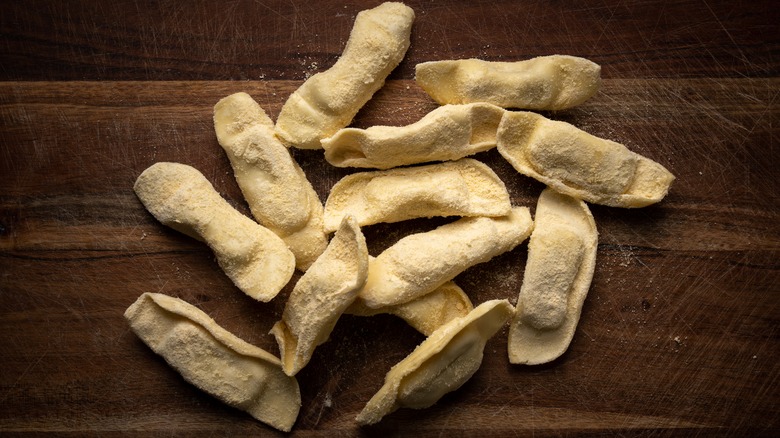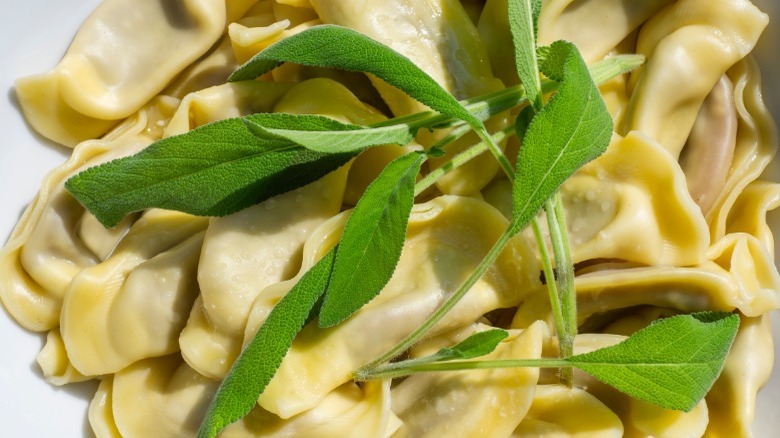If You Love Ravioli, You'll Swoon Over Casoncelli
Everyone has their personal pasta shape preference, and if you're a particularly avid pasta lover, you're probably passionate about yours. Some might argue that ravioli is an ideal form of pasta — the pasta pockets can be filled with any variety of meats, vegetables, or cheeses — and can be tossed in any number of sauces. If you love ravioli, its close cousin casoncelli could be your next pasta obsession.
Casoncelli, like ravioli, is a pocket-like stuffed form of pasta that often looks like a triangle that's had its top folded down. There are different variations, but most casoncelli more closely resemble mini dumplings than traditional ravioli or other stuffed pasta — think along the lines of a semi-circle, a folded handkerchief, or a wrapped candy. Like some other types of pasta, casoncelli dough is egg-based, and depending on where you're eating them, the pasta is shaped differently and can be filled and served with a multitude of flavors — you could see them loaded with beef and cheese or with something a little more unique like spinach and raisins.
The history of casoncelli is a little bit contentious
The origins of this particular pasta are actually contested. It turns out that two cities in Italy — Bergamo and Brescia — both claim that they were the first to come up with casoncelli. The case for Bergamo being the place of origin is based on a notarized document from 1386 that discusses something called "artibotuli," which is what modern casoncelli evolved from. Although Brescia also wants to lay claim to casoncelli, their proof is a document dated almost one hundred years later in 1471.
Each city has their own recipe for casoncelli, so it's hard to say what the true "traditional" filling could be. The Bergamo variation uses ingredients including roasted beef, salami meat, breadcrumbs, pears, raisins, and lemon rind, and are tossed in a butter, sage, and cheese sauce. In Brescia, the casconcelli are filled with a mixture that includes beef, carrots, onion, celery, and red wine — these are also topped with a butter and sage sauce. Besides the two cities dueling over the origins of casoncelli, other cities in the Lombardy region also serve their own twist, like Valcamonica where the filling recipe calls for spinach and mortadella.
What makes casoncelli different from other stuffed pastas?
There are many stuffed pastas to know and cook, so why is casoncelli any different? It boils down to technique and how this type of pasta is prepared.
Many types begin with the same egg and flour-based dough that is rolled into a sheet — the final shape dictates the rest of the process. Ravioli are typically square or round, and tortellini are ring-shaped — whereas casoncelli often take on that folded handkerchief look. To make tortellini, for example, the dough is cut into circles, filled, and then folded. For ravioli, one sheet of dough is placed on top of another and then cut to get the desired shape. When making casoncelli, the dough is rolled out thin and cut into strips. The chef then adds a small amount of filling to the center and then folds it over, creating a triangle. The top is then folded again, tucking it to create a candy-wrapper shape.
Each variety also has different occasions during which they're traditionally eaten. Ravioli are considered a "lean food" when they're not filled with meat, meaning Catholics are allowed to eat them on Fridays during Lent. Tortellini are also connected to holiday traditions — a dish called "tortellini in brodo" is often served in Catholic homes on Christmas and New Year's Eve. Casoncelli used to only be eaten by the wealthy and on special occasions like weddings but are now commonly eaten on a regular basis.



